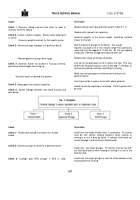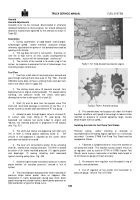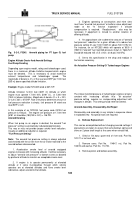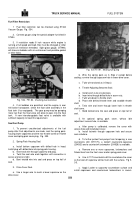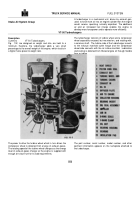TM-5-3805-254-14-P-2 - Page 551 of 894
TRUCK SERVICE MANUAL
FUEL SYSTEM
aneroid oil reservoir
Note:
Aneroid oil level will be low if leakage Is occurring
at "O" ring b A quick check to determine if aneroid is or is
not the source, disconnect aneroid fuel outlet line at
aneroid and plug end of hose and opening in aneroid.
If
air entry into fuel system continues, aneroid is not at fault.
If air entry stops, aneroid is at fault
2.
Seal, Part No.
102827 leaking.
Check in usual manner
Adjustment On Engine
Accuracy of the following adjustments depend on the condition
of the engine, parasitic loads and accuracy of the instruments
used.
At no time should adjustments be made on a cold
engine.
The engine should be run before making adjustments
until oil temperature reaches 165 deg.
F.
and with the valves
and injectors set according to specifications.
Pump Hook-Up
If the fuel pump has been removed from engine for calibration,
proper hookup is necessary.
1.
Install fuel pump to accessory drive or to compressor
with new gasket and proper rubber buffer, nylon buffer or
spline coupling and tighten securely.
Note:
Use black rubber buffer (spider) for engines rated at or
below 2800 rpm.
Use white nylon above 2800 rpm.
2.
Squirt some clean lube oil into gear pump inlet hole.
This aids gear pump fuel pickup.
3.
Connect the fuel pump line from the pump shutoff
valve to the fuel manifold or to front or rear of engine.
4.
The throttle lever linkage should not be connected to
the throttle lever, thus leaving the throttle free for pump
adjustments.
5.
Install accurate tachometer to fuel pump tachometer
drive shaft connection or use ST774 hand tachometer.
6.
Connect the shutoff valve electrical connections
properly, leaving the manual control button in a closed position
(screwed out).
7.
Connect pump cooling line to check valve elbow on
gear pump.
Checking And Adjusting
The Fuel Pump On The Engine
Before making fuel system
checks or adjustments on engine, be sure the following rules
are observed:
1.
Engine is at operating temperature.
Fuel temperature
is not above 110 deg.
F [43 deg.
C] .
2.
Engine parts are the same as those listed on Control
Parts List and in good condition.
Timing, valves and injectors
are properly adjusted.
3.
Instrumentation (gauges and tachometers) must have
high accuracy.
CAUTION
Do not alter pump settings to satisfy gauges and
tachometers of unknown accuracy.
4.
Vehicle throttle control linkage is adjusted so full
throttle is obtained and when released throttle is stopped by
front throttle adjusting screw (throttle leakage adjusting screw).
Note:
Vehicle throttle control linkage should have a maximum
throttle stop, so when fuel pump full throttle is obtained
override pressure will not be on throttle shaft.
5.
When fuel pump has been properly calibrated, very
little adjustment should be required after installation on the
engine except idle since this setting is dependent on parasitic
loads.
Fine adjustment of governor settings and fuel manifold
pressure is permissible within the specified limits if justified by
engine performance tests.
Governor Settings
Idle Speed
1.
After fuel pump installation, engine must be operated
a sufficient period of time to purge all air from the fuel system
and to bring engine up to operating temperature (at least 165
deg.
F [74 deg.
C] oil temperature).
Note:
Idle speed adjustment should never be made on a cold
engine.
2.
Remove pipe plug from spring pack cover.
3.
The idle adjusting screw is held in position by a
spring clip.
Turn screw in to increase or out to decrease the
speed. Use ST984 to adjust idle speed while engine is
running. This tool seals the spring pack housing, permitting an
accurate adjustment.
546
Back to Top


